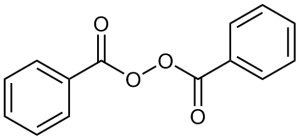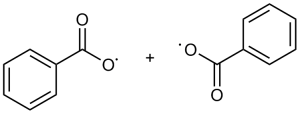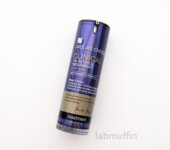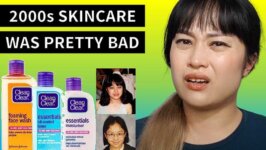Benzoyl peroxide (or BP, as it’s affectionately known) is one of those products that seems to work for everyone. It’s a topical treatment (cream) that’s an essential component of many acne treatment regimens (Dan Kern’s acne.org, ProActiv, Paula Begoun just to name a few). But what does it do, and how is it most effective?
Benzoyl peroxide is a peroxide, much like hydrogen peroxide, which is the peroxide of peroxide blondes. In chemistry, peroxide refers to the two oxygen atoms linked together. This is an unstable bond which readily breaks up into free radicals:
At the moment, benzoyl peroxide’s mechanism of action is not completely understood, but it’s thought that the free radicals kill bacteria that contributes to acne, Propionibacterium acnes, by interacting with their cell walls (their “skin”). Additionally, it seems to encourage peeling, which helps stop pores from getting clogged, which is the first part of the acne-forming process.
However, benzoyl peroxide has a number of not-so-nice side effects, including dermatitis (either from irritation which gets better after about a week, although about 1% of people can have a true allergic reaction to it) and bleaching of fabric and hair.
Benzoyl peroxide can be commonly found in concentrations between 2.5 and 10%. To minimise side effects, lower concentrations can be used. A few studies have shown 2.5% benzoyl peroxide was as effective as stronger 5% and 10% formulations. Additionally, combining BP and antibiotics (e.g. erythromycin and clindamycin) can be a good way to increase effectiveness without also increasing reactions and antibiotic resistance.
References
HH Tan. Topical antibacterial treatments for acne vulgaris: comparative review and guide to selection. Am J Clin Dermatol 2004, 5, 79.
JJ Leyden. A review of the use of combination therapies for the treatment of acne vulgaris
J Am Acad Dermatol 2003, 49, S200.
GA Taylor, AR Shalita. Benzoyl peroxide-based combination therapies for acne vulgaris: a comparative review. Am J Clin Dermatol 2004, 5, 261.








useful! is this somewhat similar to paracetamol, where they don’t really know how it works in the body (I could be wrong, but that’s what my sister told me that something to do with paracetamol is unclear at the moment)..?
Also, Michelle, do you have any tips/tricks on how to whiten nails naturally?? Will bicarb soda do anything?
Thanks 🙂
Well, how paracetamol works isn’t completely known either, but they’re very different in what they do and how they work – BP is applied on the skin and acts directly on the bacteria, whereas paracetamol is taken as a tablet, then acts on the body to reduce the sensation of pain.
It depends on what’s staining your nails, and there could be a thousand different things – sometimes bicarb can work. Usually people use bicarb with a toothbrush and scrub hard – other things I’ve heard working are lemon juice, vinegar, hydrogen peroxide and smoker’s toothpaste. Trial and error is the only way to see what works with whatever’s on your nails, unfortunately! 🙁
thanks a lot michelle 🙂
interesting post! i have a cream that is 2.5% BP and 0.1 adapalene. i’m a bit worried that those free radicals may be damaging to the skin?
I don’t think much research has been done on this unfortunately, although it’s definitely a possibility.
very interesting!!
Glad you thought so! 🙂
I’m actually one of those people who are very allergic to BP. I used an OTC face wash back in high school and my face and eyes swelled up so badly that I couldn’t see and I hurt so badly. I was out of school for a week trying to get the reaction under control. Ugh, it was awful.
Oh no! It’s been so good for my face, such a pity you can’t take advantage of this great antibacterial 🙁
I’ve had good results from bp at 2.5%, less irritating than 5-10% (cheaper too!!)
Definitely – at first I tried 10% mixed with lots of moisturiser, but I must’ve been quite heavy handed beecause I looked diseased for a week >.<
I’m also one of the few unlucky allergic ones! My skin had always been great up until about six months ago, when I started breaking out quite often. After putting up with it for a while my housemate suggested I try her holy grail pimple zatter Benzac.
I’d tried Clearasil once and broke out in hives on my face, but that was 5 or so years ago so I thought I’d give the ol’ spot pimple cream another shot (also not realising that they had the same active ingredient). Long story short, 36 hours later I was at the doctor getting a prescription for steroid tablets with an almost swollen shut eye and a very red, sore and itchy face!
A couple of years ago I also had a reaction to a throat spray that has Benzydamine as the active ingredient (hives from the waist up!) which brings me to my sciencey question… are all the benzy-whatever ingredients chemically similar? Or do I happen to coincidentally react to two similarly named ingredients? Benzy-whatever seems to be in quite a lot of things!
And the saddest part of this story is that in the 12 or so hours after I used Benzac before the allergic reaction kicked in, it appeared to have worked wonders on my pimples! They magically shrunk! And I got a free insane face peel (which to be honest I could’ve done without!)
P.S. I discovered your blog a few months ago (I’m terrible at commenting, but I’ve been avidly readying!) and I absolutely love it! I love discovering all the science behind skincare and cosmetics and what’s really in all these products we all use so frequently! And your nail art is fab! This is now the end of the world’s longest comment!
Thanks for the comment Rosie, I’m flattered! I love your nail art too 🙂
Such a pity about the BP allergy! Have you found an alternative solution to the zit problem?
With regards to the allergies, I think it’s unlikely you’re allergic to all benz- things – the “benz” part of the name refers to the hexagon on the left of the chemical here: http://en.wikipedia.org/wiki/Benzydamine
It’s a tiny part of the molecule, and from a brief look at the literature, it doesn’t break off into a smaller piece in the body to any significant extent (basically benzydamine enters and leaves the body as pretty much the same big molecule). There are also a LOT of things with that same group, for example phenylalanine, which a handful of people can’t handle (it’s in sugarfree chewing gum, and pretty much all protein – I’m assuming you don’t have problems with that since you didn’t mention it…). So I think it’s likely to be a coincidence, but you should be careful with any new things you introduce into your routine anyway – it sounds like your immune system is on the hyperactive side! 🙁
Hi Michelle! The pimplies are calming down now thankfully! I did pop into Mecca over the weekend to get a concealer and walked out with an anti aging face peel thing that the girl working there swears by! While I was in the store she used it on my face and the difference the next day was quite miraculous! I’ve also discovered serums! I think I really just need to get a better skincare regime going!
It’s good to know that I won’t have to ditch everything with “benz” somewhere in the ingredient list. My primer has benzyl alcohol in it and it’s never caused me trouble! I’ve never been one to follow the instructions and test on an inconspicuous area when using new products, but I think I might just have to!
I used to use a 2% of benzoyl peroxide spot treatment, but I now use Citrus Clear Grapefruit Spot Treatment which has 5% salicylic acid.
Every time when i breakout I just put Citrus Clear on the spot over day and night. Its gone the next day. I could not live without it. It seem like my home medicine for my breakout.
no bleaching or anything, if you just put a very thin layer.
Is using BP in the morning and then Clindamycin at night effective for preventing bacteria resistance?
I have had two really bad allergic reactions to salicylic acid, including massive swelling, blisters and difficulty with breathing. I am currently using AHA, but would like to try a more oil soluble alternative to BHA. Are there any? Thanks for the amazing job! c:
Maybe try mandelic acid? It’s sort of an AHA and BHA, but entirely unrelated to salicylic acid in terms of structure. I’m a big fan!